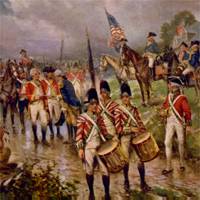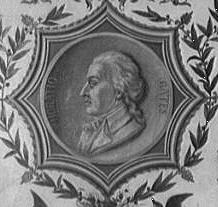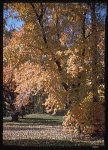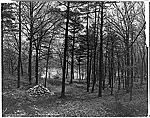Today in History: September 19
Victory at Saratoga

Burgoyne's Surrender at Saratoga,
(detail)
Percy Moran, artist,
1911.
Prints & Photographs Online Catalog
After a series of discouraging military defeats, on September 19, 1777, continental soldiers fighting under American General Horatio Gates defeated the British at Saratoga, New York. Within weeks, Gates joined forces with American General Benedict Arnold to vanquish the redcoats again at the Second Battle of Saratoga. On October 17, British General John Burgoyne surrendered his troops under the Convention of Saratoga, which provided for the return of his men to Great Britain on condition that they would not serve again in North America during the war. American victory at the Battles of Saratoga turned the tide of the war in the colonists favor and helped persuade the French to recognize American independence and provide military assistance outright.
Born at Malden, Essex, England, circa 1728-29, Gates' mother served as housekeeper to the Duke of Leeds. Gates joined the army while a very young man. He first came to the North America to fight in the French and Indian War—the American theater of the worldwide conflict called the Seven Years War. Through distinguished service in Nova Scotia, New York, and Martinique, he achieved the rank of major. Encouraged by friend and former comrade-in-arms, George Washington, he returned to America a decade later and settled in western Virginia—the frontier at that time.

Fresco in Senate Corridor in U.S. Capitol, Horatio Gates. (detail),
photograph circa 1920-50,
Washington as It Was: Photographs by Theodor Horydczak, 1923-1959
Sympathetic to the American cause, Gates' name was the first proposed by Washington when Congress asked him to nominate officers for the Revolutionary Army. In 1775, Gates accepted his nomination as adjutant general of the Continental Army and by 1777 had replaced General Philip Schuyler in northern New York. After Saratoga, Gates, an able administrator, served as president of the Board of War. He had many friends in Congress and was, perhaps unwittingly, drawn into the "Conway Cabal"—an attempt to replace Commander-in-Chief Washington with Gates. Although criticized for his conduct during the battle of Camden, he continued to serve the American cause until the end of the war.
Troubled by the issue of slavery, Gates manumitted his slaves and relocated from Virginia to New York after the Revolution. He served one term in the state legislature but much of his time and money was spent aiding Revolutionary veterans. General Horatio Gates died on April 10, 1806.
Learn more about the Revolutionary Era:
- Read Washington's correspondence with Horatio Gates. Search the George Washington Papers, 1741-1799 on Horatio Gates to find letters including Gates' first communication with his new commander-in-chief.
- View images of the Saratoga Monument erected at Schuylerville, New York, to commemorate Gates' victory over Burgoyne. The cornerstone of the one-hundred-and-fifty-foot obelisk was laid on October 17, 1877—the centennial of the Second Battle of Saratoga. Search the collection Touring Turn-of-the-Century America: Photographs from the Detroit Publishing Company, 1880-1920 on Saratoga.
- Search the Today in History Archive on Revolutionary War to read more about events in America's fight for independence.
- Visit the timeline America during the Age of Revolution, 1764-1775 featured in the American Memory collection Documents from the Continental Congress and the Constitutional Convention, 1774-1789.
- A Guide to the American Revolution, 1763-1783 compiles links to digital materials related to the American Revolution that are available throughout the Library of Congress Web site, including manuscripts, broadsides, government documents, books, and maps.
Poets and the Seasons
Where are the songs of Spring? Ay, where are they?
Think not of them, thou hast thy music too…
John Keats, "To Autumn"

Maple Trees,
Theodor Horydczak, photographer,
circa 1920-1950.
Washington as It Was: Photographs by Theodor Horydczak, 1923-1959
On September 19, 1819, English poet John Keats, inspired by the beauty of the changing season, wrote "To Autumn," a three-stanza ode to the splendor, bounty, and melancholy of fall.
Meditations on the tension between the transcendent nature of ideals and the constancy of change in the physical world, Keats's odes are considered his greatest poetic accomplishment. With the exception of "To Autumn," written in September, the odes were composed between March and June of 1819. Struggling with his own fatal illness, while mourning his brother's recent death, during this period Keats carried on an intense love affair with Fanny Brawne to whom he later became engaged.
Born in London, England, in 1795, he trained to become a surgeon before devoting himself to poetry in 1817. John Keats died of tuberculosis on February 23, 1821. Just twenty-five years old, his death cut short the life of a great poet.

Site of Thoreau's Hut
Walden Pond,
Concord, Massachusetts, 1908.
Touring Turn-of-the-Century America, 1880-1920
Close observation and description of the natural world characterized the poetry of the English Romantic Movement. Interested in the relationship of humans to the natural world, poets William Wordsworth, Samuel Taylor Coleridge, and John Keats profoundly influenced both the American Transcendentalists and the Conservation movement.
American writer Henry David Thoreau continued the tradition of the Romantic poets in his prose journals. In his journals he describes the seasonal changes of the woods around Concord, Massachusetts, and the lives of the animals and plants who were his closest neighbors during the years he spent living in a cabin on Walden pond. In the posthumously published Excursions, Thoreau describes a magnificent red maple tree:
Some single trees, wholly bright scarlet, seen against others of their kind still freshly green, or against evergreens, are more memorable than whole groves will be by-and-by. How beautiful, when a whole tree is like one great scarlet fruit full of ripe juices, every leaf, from lowest limb to topmost spire, all aglow, especially if you look toward the sun! What more remarkable object can there be in the landscape?Henry D. Thoreau, "The Red Maple" in "Autumnal Tints," Excursions, 1863, page 228.
The Evolution of the Conservation Movement, 1850-1920

Highway Scene,
West Virginia,
Theodor Horydczak, photographer,
circa 1920-1950.
Washington as It Was, 1923-1959

Trees in Rock Creek Park,
Washington, D.C.,
Theodor Horydczak, photographer,
circa 1920-1950.
Washington as It Was, 1923-1959
- Browse the Author Index of the collection The Evolution of the Conservation Movement, 1850-1920 to read selections from American naturalists, such as Thoreau, John Burroughs, and John Muir.
- Words and Deeds in American History: Selected Documents Celebrating the Manuscript Division's First 100 Years showcases the letters and drafts of several American poets and writers, including Walt Whitman, Ralph Waldo Emerson, and Langston Hughes, and many other prominent figures in American Arts and Literature. One of the documents featured in the collection is "Autumn," a poem written in 1893 by thirteen-year-old Helen Keller. Search the collection on the keyword poet to find more documents by or about American poets.
- Search the Today in History archive on poet to retrieve features on poets including Phillis Wheatley, Henry Wadsworth Longfellow, Walt Whitman, Paul Laurence Dunbar, Archibald MacLeish, Langston Hughes, and Robert Penn Warren.
- American Memory holds beautiful photographs that capture the splendors of the season. To locate these images, search the pictorial collections on the keyword autumn.